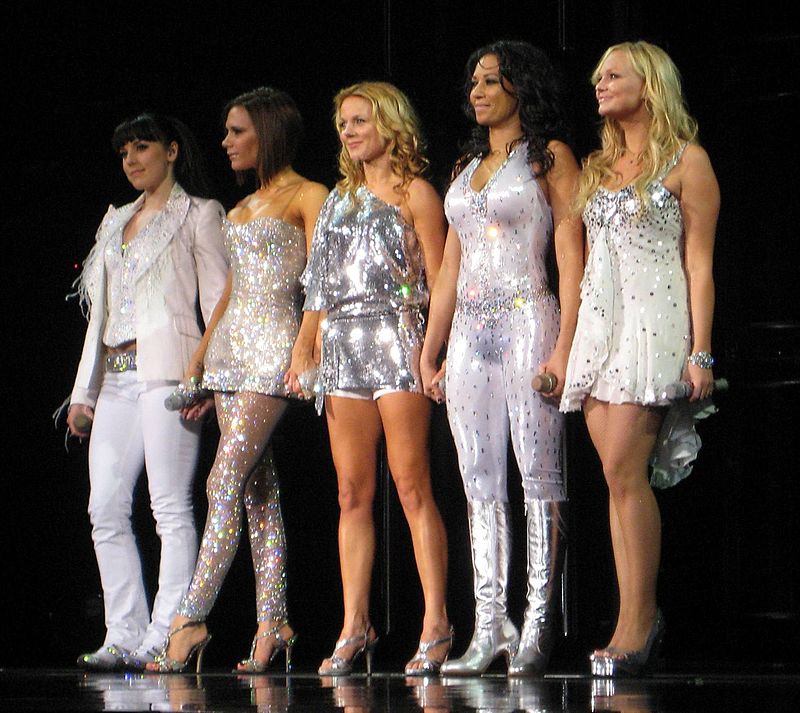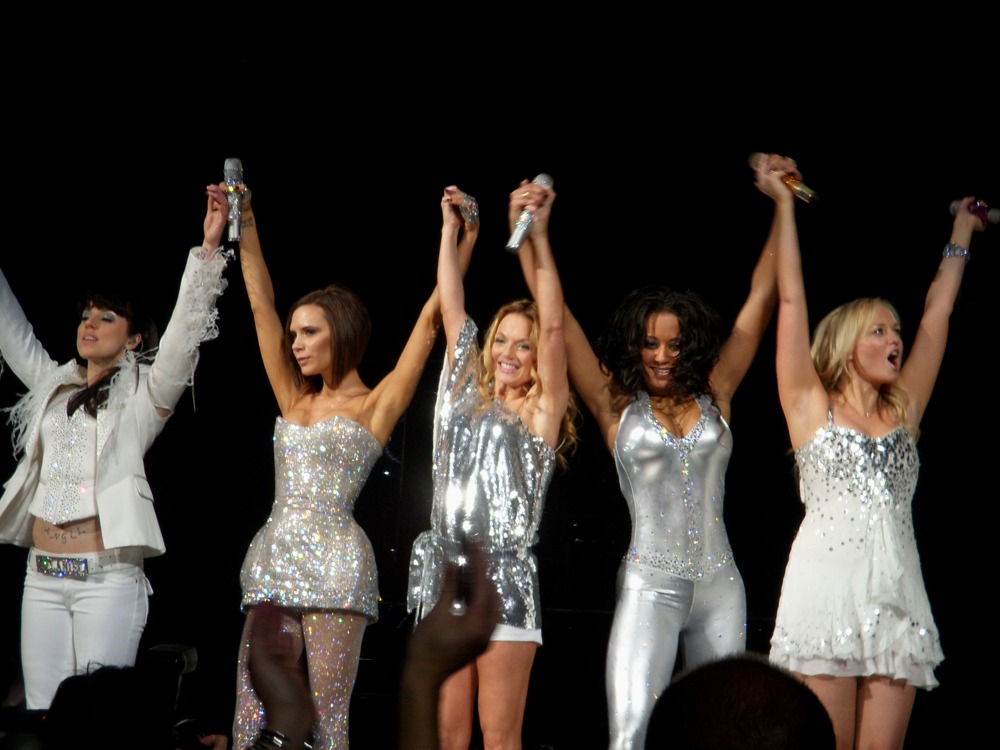Popular music serves a significant social and cultural function. It expresses social attitudes and serves as a source of role models. The Spice Girls exploded onto the scene in the late 1990s, enthralling audiences worldwide with their catchy pop songs and flamboyant personalities. They continue to be pop culture icons because their music is timeless and because their fashion sense and feminism will always be a constant.
Read on for more information about the Spice Girls and their unforgettable impact.
The Rise of the Spice Girls
In the late 1990s, the Spice Girls were a British musical group whose songs dominated global charts. Geraldine Halliwell, Melanie Chisholm, Victoria Adams (later Victoria Beckham), Melanie Brown, and Emma Bunton were members of the group, though they became known as Ginger Spice, Sporty Spice, Scary Spice, and Baby Spice.
They were contracted to Virgin Records and released their debut single “Wannabe” in 1996, which topped the charts in 37 countries and established their international success. Their debut album Spice sold over 31 million copies worldwide, making it the best-selling female group album in history. Spiceworld, their subsequent album, sold over 20 million copies worldwide. The Spice Girls have sold 100 million records worldwide, making them the most successful female group of all time, one of the most successful pop groups of all time, and the most successful British musical act since The Beatles. Time referred to them as “arguably the most recognizable face” of Cool Britannia, the mid-1990s celebration of British adolescent culture, as one of the most prominent acts of 1990s popular culture.
Indicators of their success include international record sales, a 2007–2008 reunion tour, a 2019 reunion tour, merchandising, iconic symbolism such as Halliwell’s Union Jack dress representing “girl power”, and a film, Spice World. In May of 1998, the group’s global gross income was estimated to be between $500 million and $800 million, making them one of the most successful marketing vehicles in history. Under the guidance of their mentor and manager Simon Fuller, the Spice Girls embraced merchandising and rose to prominence in the British and international press. In 1996, Top of the Pops magazine assigned aliases to each member of the group, which were subsequently adopted by the group and media. According to Rolling Stone journalist and biographer David Sinclair, “Scary, Baby, Ginger, Posh, and Sporty were the most widely recognized group of individuals since John, Paul, George, and Ringo”. The Spice Girls were well-known cultural icons of the 1990s due to their “girl power” moniker. They are cited as part of the ‘second wave’ of British invasion of the United States in the 1990s.
Spice Girls’ Impact on Pop Culture
Through their music and image, the Spice Girls significantly influenced the popular culture of the 1990s by promoting female power, individuality, and friendship.
The Spice Girls, a British pop female group became an international sensation almost immediately. They played a significant role in shaping the decade’s popular culture, particularly through their promotion of “Girl Power.” This message encouraged young girls and women to be self-assured, assertive, and independent. The group’s infectious pop melodies and empowering lyrics resonated with a generation of young women and helped to mainstream the idea of female empowerment in popular culture.
Scary, Baby, Ginger, Posh, and Sporty were the nicknames given to each member of the Spice Girls, respectively. This individuality contributed significantly to their appeal, as it enabled fans to identify with the band member they felt best represented them. This was a departure from the typically homogenous image presented by pop groups, and it reinforced their message of uniqueness and self-expression.
Additionally, the Spice Girls emphasized the significance of friendship. Their companionship was evident both on and off stage, and ‘friendship never ends’ was a common refrain in their music. This emphasis on friendship, as opposed to romantic relationships, was a welcome change to the pop music landscape, and it resonated with their young audience.
Furthermore, the influence of the Spice Girls extended beyond music. They were astute businesswomen who capitalized on their fame through a variety of merchandising agreements and a worldwide hit film, ‘Spice World’. This demonstrated their influence and scope and strengthened their position within popular culture.
Let’s read in detail on this Spice Girls impact!
How Spice Girls Influenced Popular Culture
A Comeback of Bubblegum Pop
In the 1990s, grunge became mainstream, R&B acts such as TLC and Toni Braxton flourished, and Brit-pop indie titans such as Blur and Oasis enjoyed worldwide success. Midway through the 1990s, the arrival of the Spice Girls allowed a new generation of young music enthusiasts to express their appreciation for bubblegum pop. From US megastars such as Britney, *NSYNC, and Backstreet Boys to UK acts such as S Club 7, Five, and Steps, the era of bubblegum pop that the Spice Girls helped herald in spawned many successful groups.
The Revolution of Girl Power
The Spice Girls popularized the ‘girl power’ mantra. Whenever this phrase is used, images of Geri shouting “Girl Power!” spring to mind. The significant cultural transition that the Spice Girls contributed to cannot be understated. As the underground feminist punk rock movement gained momentum, the Spice Girls mainstreamed the spirit of female power. At a time when the majority of males in the music industry objectified women, the band set a precedent that led to many girls taking the stage.
The turbid waters of the music industry are notoriously unjust. The majority of women who want to succeed in the industry are frequently required to give sexual favors, and when they are signed, they are sexualized with the phrase ‘sex sells’. The Spice Girls did not perform a sensual act. There were no sexually suggestive undertones in their lyrics. There was no risk of hearing profanity when listening to the Spice Girls. Girl power is potent enough to neutralize misogyny and sexualisation in the music industry, as evidenced by the girls’ incredibly pure magazine covers.
Developing a Brand
Nowadays, it’s not uncommon to see an abundance of product placement in music videos or your favorite artist selling merchandise with a hashtag. Before the Spice Girls, it wasn’t unusual for pop stars to promote products, but Spice took it to a whole new mass-market level, from big-name collaborations with Pepsi, Impulse, Chupa Chups, and Polaroid, to name a few, to a slew of official merchandise (imagine a Spice magazine? Or perhaps some dolls? Alternatively, stationery?). The Spice Girls had a no-regrets approach to monetizing their image, which would become standard for modern musical stars and celebrities in general.
Spice Girls and Trends
Through their distinctive style and fearless dispositions, the Spice Girls significantly influenced how people dressed and expressed themselves. They were known for their daring fashion choices, which frequently involved combining different styles to create their own signature appearance. From platform shoes to crop tops, they pioneered new fashion trends that would eventually become iconic.
Not only was their influence felt in the music industry, but also in the fashion industry. The Spice Girls demonstrated that apparel could be used for self-expression and emancipation. They inspired individuals everywhere to take risks with their personal style by encouraging admirers to embrace their uniqueness through clothing. Their message was unmistakable: Be yourself and don’t be hesitant to stand out.
Celebrity influence and fashion trends may dictate what is popular or “in” at the present, but it is essential to remember that fashion is ultimately a form of expression. The influence of the Spice Girls on fashion exemplified this precise concept; each member had a distinct style that reflected their individuality. From Scary Spice’s daring animal prints to Baby Spice’s girly pastels, they demonstrated that there is no one way to dress and encouraged admirers to embrace their individual preferences.
Using fashion as an instrument for empowerment requires unapologetic self-expression. It entails donning what makes you feel confident and comfortable, regardless of the latest trend or what everyone else is wearing. The Spice Girls were renowned for their daring fashion choices that reflected each member’s individuality and encouraged young women worldwide to embrace their individuality.
The Greatest Hits
At their peak, the Spice Girls had hits; not just successful singles, but durable, well-crafted pop songs that took the personality of the group and distilled it into bratty, clever dance-pop: “Wannabe” was a terrific debut single that still holds up, “Say You’ll Be There” demonstrates how the R&B influences on their debut single reflected the musical climate of the era, and “Spice Up Your Life” demonstrates how the group’s personality was distilled into The Spice Girls’ forward-thinking, yet approachable, music demonstrated that contemporary music could be entertaining, tongue-in-cheek, and humorous. And on ballads such as “Viva Forever” and “2 Become 1,” the ladies demonstrated that they were capable of performing a stellar pop ballad without resorting to brashness.
Iconic Status
Cultural impact, sometimes referred to as “Spicemania,” pertains to the significant effect exerted by the Spice Girls on the music industry. This influence was mostly attributed to their embodiment of third-wave feminism and promotion of female empowerment, ultimately resulting in their attainment of multi-platinum status as a female musical ensemble.
The Union Jack dress worn by Geri Halliwell during her performance at the 1997 Brit Awards has attained iconic status, becoming one of the most prominent pop culture symbols of the 1990s. The dress was sold to the Hard Rock Cafe in Las Vegas for a record £41,320 at a charity auction, earning Halliwell the Guinness World Record for the most expensive piece of pop star apparel ever sold. The garment was one of many pieces of Spice Girls memorabilia sold at the charity auction, which raised a total of £146,528.
The Spice Girls’ ubiquity in the 1990s can also be attributed to their merchandising and willingness to participate in a media-driven world. They advertised for numerous brands and even parodied themselves in the music video for “Spice Up Your Life,” in which the band flies in a spaceship surrounded by billboards and advertisements featuring them. Due to their frequent appearances in advertisements and the media, the band became a phenomenon — an icon of the decade and of British music. The Spice Girls were ranked tenth on E!’s special The 101 Reasons the ’90s Ruled.
Conquering America
For non-American acts, “conquering America” is often viewed as crucial, if not difficult to achieve. Even if you have conquered markets such as Australia or Europe, the United States is the primary objective for any major pop star. One Direction and Little Mix have done well in the United States due to social media and a fan base built on reality television, but the Sugababes, Robbie Williams, and Atomic Kitten have not. In 1997, the Spice Girls were able to sell albums and make America comprehend their particular brand of pop without having to dumb it down or change themselves to accommodate cultural preferences, demonstrating the universal power of their material and easily conquering large territories.
In conclusion,
it can be said that the Spice Girls exerted a significant influence on the cultural landscape of the 1990s. The aforementioned individuals effectively disseminated ideas pertaining to female empowerment, personal autonomy, and camaraderie, so establishing a profound connection with their target demographic and exerting a significant impact on the prevailing sociocultural milieu. The impact of their influence extended beyond the confines of the music industry, permeating society at large, as they played a pivotal role in redefining the societal construct of young womanhood in the 1990s.


